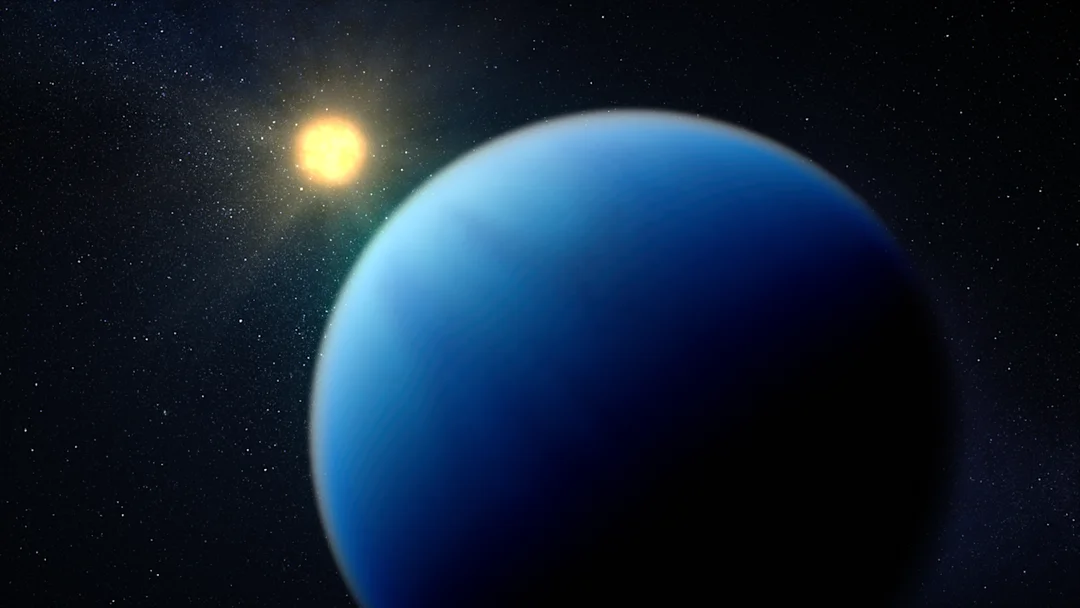
James Webb Telescope Unveils Watery Secrets of Exotic Exoplanet TOI-421 b: A Breakthrough in Sub-Neptune Research
In a groundbreaking discovery, NASA's James Webb Space Telescope (JWST) has detected water vapor in the atmosphere of TOI-421 b, a hot, exotic sub-Neptune exoplanet. This finding challenges existing theories about the formation and evolution of such planets and offers unprecedented insights into a class of exoplanets that are surprisingly common but poorly understood.
The study, published in The Astronomical Journal Letters, marks a significant advancement in exoplanet research. Prior to JWST, attempts to study the atmospheres of sub-Neptunes often resulted in flat or featureless spectra, obscuring the chemical composition of these alien worlds. Astronomers suspected that clouds or hazes were responsible for this lack of detail. However, the research team believed that TOI-421 b, with its high temperature, might offer a clearer view.

TOI-421 b, located approximately 244 light-years from Earth, orbits a star similar to our Sun. Its estimated atmospheric temperature of 1,340 degrees Fahrenheit places it above the threshold where hazes are less likely to form. Using JWST's Near Infrared Spectrograph and Near Infrared Imager and Slitless Spectrograph instruments, scientists were able to observe two transits of the planet and gain a rich atmospheric profile.
"We saw spectral features that we attribute to various gases, and that allowed us to determine the composition of the atmosphere," said Brian Davenport, a Ph.D. student at the University of Maryland, who led the data analysis. The team detected water vapor, along with possible signs of carbon monoxide and sulfur dioxide. Notably, they did not find evidence of methane or carbon dioxide. The data also suggests a significant amount of hydrogen in the atmosphere.
One of the most surprising discoveries was the hydrogen-rich atmosphere, which closely resembles the composition of TOI-421 b's host star. As Eliza Kempton, principal investigator and professor of astronomy at the University of Maryland, explained, "If you just took the same gas that made the host star, plopped it on top of a planet's atmosphere, and put it at the much cooler temperature of this planet, you would get the same combination of gases." This suggests a formation process more akin to giant planets in our solar system than previously observed sub-Neptunes.

This discovery is particularly significant considering that sub-Neptunes are the most common type of exoplanet in our galaxy. Understanding their formation and evolution is crucial in understanding the diversity of planetary systems throughout the universe. One puzzling aspect of exoplanets is the "radius gap", a relative scarcity of planets between 1.5 and 2.0 Earth radii. Further research on planets like TOI-421 b can provide clues to this mystery.
As Kempton stated, "By studying their atmospheres, we're getting a better understanding of how sub-Neptunes formed and evolved, and part of that is understanding why they don't exist in our solar system."
The findings raise intriguing questions about whether TOI-421 b is representative of hot sub-Neptunes orbiting Sun-like stars, or if it is a unique case. Further observations of similar exoplanets will be crucial to understanding the broader trends in exoplanet formation and evolution.
What other surprises might JWST uncover as it peers deeper into the atmospheres of distant exoplanets? Share your thoughts and predictions in the comments below!